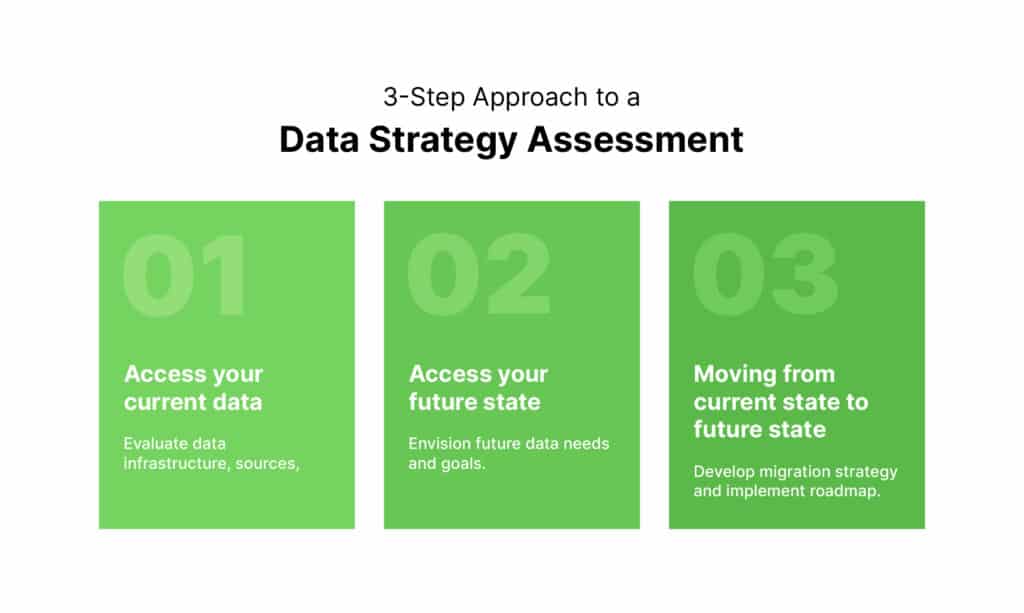Businesses generate vast volumes of data daily. According to an estimate, by 2025, 181 zettabytes of data will be produced worldwide. Which is huge!
Naturally, where there’s data, there are challenges. Data integrity, reliability, validity, data timeliness, silos, and management are some of the common challenges that consistently confront data strategists, data architects, CTOs, and CIOs. Amidst these challenges, businesses often question the quality of their data, wondering if it’s useful enough to drive business value and support data-driven decision-making.
After all, data is only valuable when put to use. Unfortunately, issues such as incomplete, siloed, duplicated, and outdated data can keep a business from making the most of it. Establishing a data strategy, however, can help address these issues and more.
This explains why businesses are increasingly approaching data strategy assessment to identify strengths, weaknesses, opportunities, threats and close any gaps within their data ecosystem. In a recent study based on data analytics adoption, IDG predicted that 78% of business executives believe that data analytics will change the business operations in the next three years. Only 46% of business leaders have a well-defined and communicated data analytics strategy. Considering this gap, data strategy assessment has become more imperative for businesses in the age of data and AI.
This blog touches upon what, why, and how of data strategy assessment, equipping you with the right knowledge to build a roadmap for successful data strategy.
What is data strategy assessment?
Data strategy assessment is a structured review process that provides insights into an organization’s data maturity within its data ecosystem. It is a comprehensive evaluation of an organization’s data-related processes, systems, and infrastructure to determine their effectiveness and alignment with strategic objectives. This assessment typically involves reviewing data governance practices, data quality, data management procedures, technology architecture, and overall data strategy alignment with business goals.
The goal is to identify strengths, weaknesses, opportunities, and threats related to data management and provide recommendations for improvement to optimize data utilization and drive business value. In simple words, data strategy assessment process aims to take a deep dive into an organization’s data pool to assess its health and identify areas for improvements.
As explained above, a well-executed data strategy assessment includes evaluating:

By carefully accessing these factors your business is more likely to identify gaps and inefficiencies in your existing data pools and uncover opportunities for improvement.
Why should businesses conduct data strategy assessment?
The whys of data strategy and assessment cannot be understated.
A data strategy assessment gives you a clear snapshot of your data landscape and looks for areas of improvement. It plays a critical role in ensuring that organizations have the right data, of the highest quality, available at the right time, to support their business objectives and drive success.
Furthermore, data strategy assessment fosters a data-driven culture within an organization. Through data maturity assessment, a business can:
- Identify weaknesses
Data assessment strategy helps identify weaknesses and gaps in the organization’s data infrastructure, such as data quality issues, inefficient data management practices, or data silos. Through this information, an organization can create targeted strategies to address the identified issues and ensure their data is accurate, accessible, and effectively utilized.
- Improve decision-making
A data strategy assessment ensures that the data used for analysis is accurate, reliable, and relevant to the decision-making process. By implementing data management best practices, organizations become more confident about their data to make decisions with the insights they need to drive business success.
- Enhance competitiveness
With a robust data strategy in place, organizations can gain a competitive edge by leveraging data to drive innovation, improve customer experiences, and respond swiftly to market changes. By staying ahead of the curve with innovative data-driven approaches, organizations can differentiate themselves from competitors and capture market share.
How does a data strategy assessment work: A step-by-step guide
Data strategy assessment evaluates your current data landscape, outlines a roadmap for future goals, and helps outline a strategic plan to bridge the gap between the two.
Let’s guide you through a three-step data strategy assessment process. This will chart a course toward a future where data is strategically leveraged to drive success within your organization.











